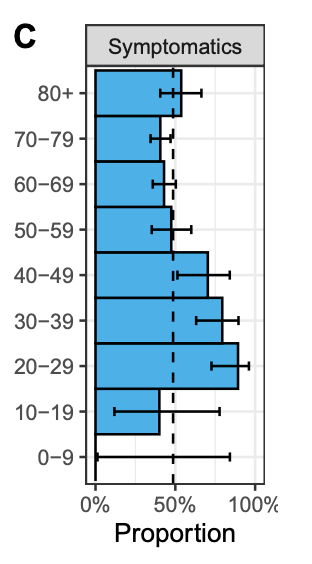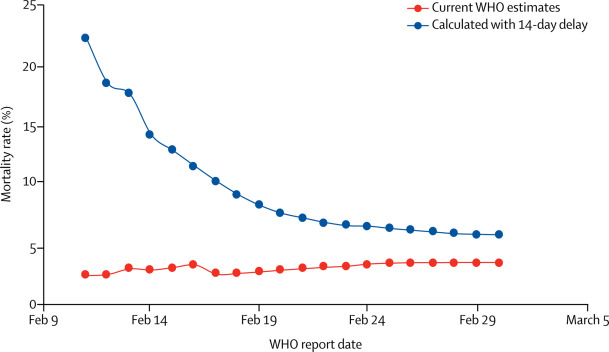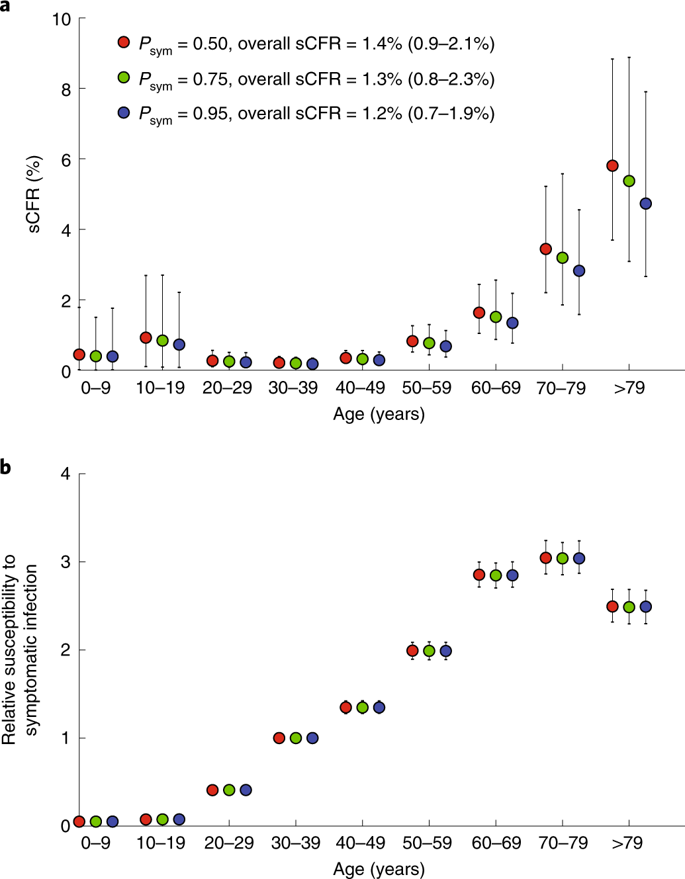Coronavirus lockdown: balanced on a knife edge
Countries around the world are going into more-or-less complete states of lockdown in an effort to stop the spread of novel coronavirus. The question I find myself asking is whether the obvious economic cost of this can possibly justify the benefits. I built a model to answer this question and I find that, contrary to my priors, lockdown is actually justifiable under reasonable assumptions.
The key inputs to the model are:
- What fraction of cases are symptomatic?
- What fraction of symptomatic cases result in death?
- How do these quantities vary with age?
- In the absence of lockdown, how much of the population will eventually contract the disease?
- What are the costs of lockdown?
At this stage, the first 3 questions can be answered with some precision.
Asymptomatic case fraction
On the Diamond Princess, 3063 of 3711 people was tested and so we know that roughly 50% of cases were asymptomatic (318 asymptomatic cases versus 308 symptomatic). Estimates from Wuhan transmission dynamics come up with a very similar figure:

Case fatality rate
sCFR is the symptomatic case fatality rate: the fraction of people with symptoms who will eventually die. I consider three sources of evidence for this:
- We know the number of infections and deaths on the Diamond Princess with certainity (there are a few people who haven’t yet died or recovered but this is negligible). Implied sCRF from a model fit to the data from the ship are as follows:

- We can also make an estimate using data from Wuhan, which is well-studied at this point.

- However, it seems very likely that a large number of Wuhan cases remain undiagnosed. Studies that try to adjust for this by using estimated transmission dynamics or the results of tests done by other countries on travellers from Wuhan find sCFR much more in line with the Diamond Princess experience:


We can take the mean of these three models to estimate the sCFR:
| Age Range | sCFR Diamond Princess | sCFR Wuhan (from transmission rates) | sCFR Wuhan (from Travellers) | sCFR Mean |
|---|---|---|---|---|
| 0 - 9 | 0.00% | 0.01% | 0.50% | 0.17% |
| 10 - 19 | 0.00% | 0.02% | 1% | 0.34% |
| 20 - 29 | 0.20% | 0.09% | 0.30% | 0.20% |
| 30 - 39 | 0.22% | 0.18% | 0.20% | 0.20% |
| 40 - 49 | 0.42% | 0.40% | 0.35% | 0.39% |
| 50 - 59 | 1.29% | 1.30% | 1% | 1.20% |
| 60 - 69 | 3.61% | 4.60% | 2% | 3.34% |
| 70 - 79 | 8.00% | 9.80% | 3% | 6.93% |
| 80 - 89 | 14.76% | 18% | 5.50% | 12.75% |
For comparison, the sCFR for seasonal flu is 0.1% overall. The average over all age groups for coronavirus is about 0.7%. The Spanish Flu seems to have had sCFR of between 10 and 20 percent.
If uncontrolled, how widespread would it be?
Seasonal flu has R0 1.3 and about 3-11% of the population get it each year. Spanish Flu had an R0 of 2.0 and spread to about one third of the world. Measles has an R0 of 10 and spread to 80% of the Faroe Islands when it arrived there.
If uncontrolled, coronavirus R0 is probably around 2.2. Based on the experience with other diseases we can expect that uncontrolled it would spread to somewhere between one-third and 50% of the population.
What are the benefits of lockdown?
I take the sCFR and the probability of having a symptomatic infection, and multiply it by the number of people in each demographic group in the United Kingdom to find the expected number of deaths in each category.
Using actuarial life tables I work out the number of years of life lost as a result of each death. Because many of the people who die have preexisting conditions, I say that they would only have lived for 80% as long as an average person of the same age had the coronavirus not done them in.
Results are as follows:
| Age Range | sCFR Mean | Unconditional Death Probability | Expected Deaths | Expected Person-Years Lost |
|---|---|---|---|---|
| 0 - 9 | 0.17% | 0.01% | 631 | 38,583 |
| 10 - 19 | 0.34% | 0.09% | 6,530 | 347,408 |
| 20 - 29 | 0.20% | 0.06% | 5,085 | 230,593 |
| 30 - 39 | 0.20% | 0.06% | 5,010 | 188,274 |
| 40 - 49 | 0.39% | 0.12% | 10,854 | 325,418 |
| 50 - 59 | 1.20% | 0.30% | 23,035 | 522,255 |
| 60 - 69 | 3.34% | 0.83% | 56,897 | 902,152 |
| 70 - 79 | 6.93% | 1.56% | 69,716 | 682,942 |
| 80 - 89 | 12.75% | 3.19% | 76,964 | 390,975 |
| 90+ | 17.75% | 4.44% | 21,126 | 49,688 |
| 275,848 | 3,678,287 |
So allowing uncontrolled spreading costs maybe 3.6 million person-years of life and 275k deaths in the UK. It seems likely from the Chinese experience that lockdown can prevent all or most (90%+) of this loss.
My full model is available online.
What are the costs of lockdown?
The cost of lockdown are easy to enumerate but hard to quantify. Losses include:
- Unemployment and resultant financial hardship
- Higher expected future taxation to recoup the costs of government intervention
- Loss of wealth, both in the form of stock/bonds held in investment accounts, and in ownership stakes of e.g. small privately-held business. This may cause things like later retirement if pension schemes are unable to meet their obligations to pensioners.
- Loss of utility due to social distancing: fewer parties, no cinema or theatre trips, no foreign holidays.
The best-articulated endgame for lockdown is from Imperial College. Their model assumes periods of on-again-off-again lockdown for 18 months designed to “flatten the curve” to a level that the healthcare system can deal with. After 18 months herd immunity has reached a level where lockdown can be completely lifted. You would also expect a vaccine or wide-scale blood plasma infusions to be deployable within 12-18 months, which puts a cap on the length of any lockdown.
I crudely estimate the costs of lockdown by saying that all 63 million people in the UK are in lockdown for 12 months and suffer a 15% quality of life penalty as a result of lockdown. This implies 9.5 million person-years of life lost as a result of lockdown. What I find striking is that this number is only a factor of 2 to 3 higher than the estimated 3.6 million person-year benefit from lockdown. So while from a cost-benefit-analysis point of view lockdown does look like the wrong choice, with only slightly different assumptions it would start to look attractive.
Another way to compare is to multiply the number of person-years saved by lockdown by the £30,000-per-person-year threshold used by the NHS to decide whether or not the public should pay for a medical treatment. This method implies that we should be willing to spend about £110bn to avoid the consequences of uncontrolled spread. Goldman Sachs estimates that lockdown would cost about 6-7% of GDP in the long run, i.e. about £130bn in the UK. From this financial point of view a policy of lockdown also looks totally defensible, and whether or not the costs exceed the benefits will depend on your exact assumptions.
Conclusion
Whether or not to go into lockdown is a hard decision because reasonable people can disagree on whether it makes sense from a cost-benefit perspective. This was surprising to me!
Areas where you might reasonably disagree with my model include:
- If you think that the costs of the lockdown will lead to a utility drop of less than 15%, or can be implemented by locking down the country for substantially less than 12 months
- If you don’t subscribe to the ethical theory of utilitarianism at all (mine is a very utilitarian approach!)
- If you believe that the lives of old people should be counted equally with the lives of the young then your estimate of the negative consequences of uncontrolled spread would increase
On the other hand, if you think that almost all of the people who die from coronavirus would have died soon from something else, then the case for lockdown will look untenable.
A few factors that don’t really make a difference to the model:
- In an uncontrolled spread scenario, many people would get ill but not die. Assuming that every symptomatic person is sick for 7 days and then recovers, the UK loses only 297,404 person-years to sickness, which isn’t even close to the losses due to actual deaths. It seems to me that deaths are the right thing to focus on in the “costs” column, though I concede that it’s possible that a small number of those who recover will suffer permanent respiratory damage to - I don’t have a firm grip on how common this is.
- In a recession, mortality actually falls due to better cardiovascular health and fewer traffic accidents (you don’t need to commute to work if you are unemployed!). This probably only saves around 472,500 person-years so can’t do much to offset the utility losses from a lockdown-induced recession.
One key limitation of my approach here is that I only compare two policy scenarios: complete lockdown and uncontrolled spread. Countries with effective government responses (e.g. China, South Korea and Singapore) have found middle ground between these two extremes that involve comprehensive efforts to track back detected cases to other potential infectees. These seem clearly preferable to either of the scenarios I consider but to date no European government seems capable of implementing this.
Perhaps a partial lockdown of just the most at-risk groups could also make sense (h/t Steve Hsu). However, proposals to quarantine just the oldest in our society don’t obviously make sense to me, since only ~55% of the lost person-years are suffered by those who are 60 or older: although young people are less likely to die, they also have more time left to live!